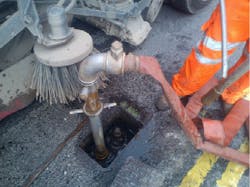Beware ye olde water pirates
How smart meters can help utilities beat water theft
In recent years, a growing number of water utilities around the world have reported instances of water theft and unauthorized usage. How might the adoption of smart water meters and network sensors enable utilities to identify illegal activity and increase prosecutions?
By Andrew Williams
Swashbucklin: There are many cases of unpaid unauthorized access to water supply.
Water theft is the unauthorized and unpaid access to water supplies from public or private suppliers. The extent of this challenge depends very much on the experiences of individual utilities and the countries they operate in, as well as on how much water each utility actually knows it is losing, according to Seth Cutler, senior industry analyst - energy & environment at Frost & Sullivan.
In his view, not all utilities will be able to clearly quantify how much non-revenue water is down to losses across the network, users that access water supplies for free - for example fire departments - and water lost through unauthorized connections.
“There are issues around unauthorized access to water networks in places like India - but there is an argument to be made in some cases where locals are forced to illegally tap into water networks. So how big the problem is a relative question,” he says.
“There is, however, recent data released by [UK water utility] Thames Water, showing a rise in illegal connections experienced by the company - spiking from 33 in 2011 to 734 in 2017,” he adds.
Severn Trent Prosecutions
Another company that has recently experienced a sharp rise in the instance of water theft is UK water utility Severn Trent.
As Dan Littlewood, senior water fittings technician at the company, explains, the theft of water is a huge problem, not only because numerous companies and individuals are taking water from networks via illegal standpipes without paying for it, but “more worryingly - their doing so is putting the quality of water to customers at risk”.
“Operatives who operate illegally are not trained, and their actions cause issues with the network, which we refer to as ‘transient surges’. These surges very often lead to discolouration or loss of supply to many customers,” he says.
According to Littlewood, the culprits can come from “all manner of industries” - and he reveals that staff at Severn Trent have dealt with numerous cases of “road sweepers and highways operatives to fun fairs and wheelie bin cleaners.”
However, despite the fact that the company’s ongoing zero tolerance policy appears to be having a positive effect on most industries, he reports that the construction industry is “unfortunately proving to be somewhat of an ongoing issue.”
“Since 2016, Severn Trent has been very active in tackling the issue. To take water without consent from the water company is a criminal offence and contravenes the Water Industry Act 1991 [a piece of UK legislation relating to the regulation of the domestic water industry]. As such, Severn Trent have prosecuted 49 cases of illegal use, and warned over 170 companies,” he says.
Deterrence, detection and enforcement
Meanwhile, Dan Pinney, director of Advanced Metering Infrastructure at smart metering supplier Sensus (a division of US water technology company Xylem) explains, the term “unauthorized use” is generally preferred over theft, because theft ‘implies adjudication.’
In this light, he reveals that unauthorized use is often grouped into four main types: tapping – the act of withdrawing water from the distribution system by connecting to a source supply such as a water main or service line; misuse – the act of withdrawing water from the distribution system from a connection in an authorized manner such as a fire hydrant, unmetered fire line, closed service valve, or flushing station; bypassing – the act of obtaining water by redirecting the flow of water around a meter; and, tampering – the act of altering the measurement of the flow to reduce the registered consumption.
In attempting to reduce the amount of unauthorized use, Pinney points to three key factors - deterrence, detection, enforcement. Deterrence is the design of the system to make the access, or ease of the process to obtain the water more difficult. Detection is the ability to be aware of the act - with additional key inputs relating to the “location and timeliness of the detection”. Enforcement relates to the due process of compliance with laws and associated rules.
For the most part, he reveals that water utilities have focused on deterrence and inspections in the past, with the use of locks, fences, seal wires, tamper resistant screws and packaging often common components within the design of the system. However, as measurement technology becomes ever more sophisticated, he observes that smart water systems now include additional capabilities to provide both increased deterrence and higher levels of detection - including “faster awareness and location of potential unauthorized use.”
In doing so, he explains that such systems can provide additional security notification and alarms regarding access to pump stations, tanks, and vaults. Smart water alarms can also be included that detect instances of tampering such as magnetic tampering, register removal, communications loss and reverse flow.
“The use of smart water analytics can provide near real time mass balances to indicate loss in a specific area. Additionally, smart water analytics can use pressure monitoring to detect potential withdrawals in an area,” he says.
“Smart water systems can also monitor fire hydrants and the position of bypass valves to detect the presence of water in a hydrant and opening of a bypass valve to provide timely indication and location of potential unauthorized use,” he adds.
In general terms, Cutler observes that the main advantage of deploying smart water meters is that they can provide utilities with a closer to real-time awareness of changes to water consumption - alerting them more quickly to discrepancies between water pumped into the system and water consumed by metered end users.
“For accounts that have not paid their bills, in some locations utilities are able to shut off supply, but in many places shutting off supplies would not be possible and would be controversial. Illegal access points, however, would not have a meter so a smart meter would not be a direct data point,” he says.
“Smart meters can have an impact in letting a utility know if a customer is trying to tamper with it, or reversing the flow to trick the meter. Improvements to meter technology, moving away from mechanical meters, towards solid state technology also help here,” he adds.
Not all utilities will be able to clearly quantify how much non-revenue water is down to losses across the network
Cost Versus Benefit
When it comes to making the decision over how much resources to devote to the issue, Cutler argues that utilities will need to make a judgement on how much water theft is costing them against how much it will cost to tackle it - in much the same way that they must make assessments relating to reducing water losses in the network. Because water is an “underpriced commodity”, he also believes that the cost of ending some or all theft can sometimes be more than the water itself is worth, meaning that there are “some utilities or some instances where companies probably do nothing aside from ongoing repair and maintenance to keep up the stability of the network”.
Illegal standpipe: Severn Trent has prosecuted 49 cases of illegal use and warned over 170 companies
“However, technologies like metering at key junctions and endpoints, acoustic monitoring, and other sensors will certainly be deployed,” he adds. “New pricing strategies could also be deployed, where those who illegally tap water supplies because they are unable to afford it are better subsidized by the whole.”
In recognition of the ongoing need of some companies to obtain water remotely, Littlewood reveals that Severn Trent now also operates an approved hire scheme in conjunction with Aquam Water Services. As he explains, the hire scheme not only gives users an approved method of obtaining water, but also ‘gives users the training required to ensure their use does not have adverse effects on the network.’
“In addition Severn Trent provide all approved pipe users with a ‘mapping’ system of identifying only safe outlets for approved water abstraction,” he says.
Ultimately though, Littlewood is confident that the zero tolerance policy adopted by Severn Trent in response to unauthorized use appears to be no be resonating through the industry, with many more water companies now following the company’s lead and starting to take legal action against illegal users.
“Going forward, Severn Trent will continue to adopt a zero tolerance policy. In addition we will continually develop our approved hire scheme - and the benefits that go with it such as the training and mapping systems provided,” he adds.
infrastructure sensors
In the coming years, Cutler believes that the situation will remain ‘fairly steady as it goes, largely due to the economic cost of ending unauthorized water access compared to the cost of the lost water.’ That said, he points out that a greater integration of network infrastructure sensors will make it cheaper for utilities to detect the location and level of unauthorized access.
“Utilities may better detect the largest sources of unauthorized water access and end the losses,” he says.
In the future, Pinney predicts the use of more data in faster time frames to detect unauthorized use - particularly in view of the fact that the flow of water through a pipe is a ‘simple function of velocity, elevation, pressure, and friction.’
“The elevation and friction are fairly static, as we increase the ability to measure and relate velocity and pressure to a location, a smart water system will increase the ability to detect unauthorized use,” he adds.
Andrew Williams, based in the UK, is a freelance correspondent for WWi magazine.


